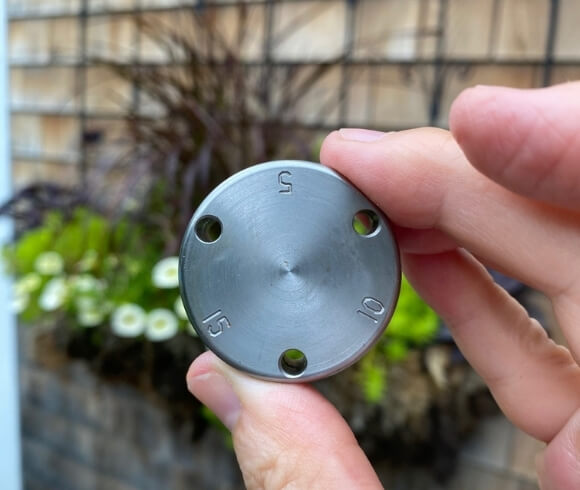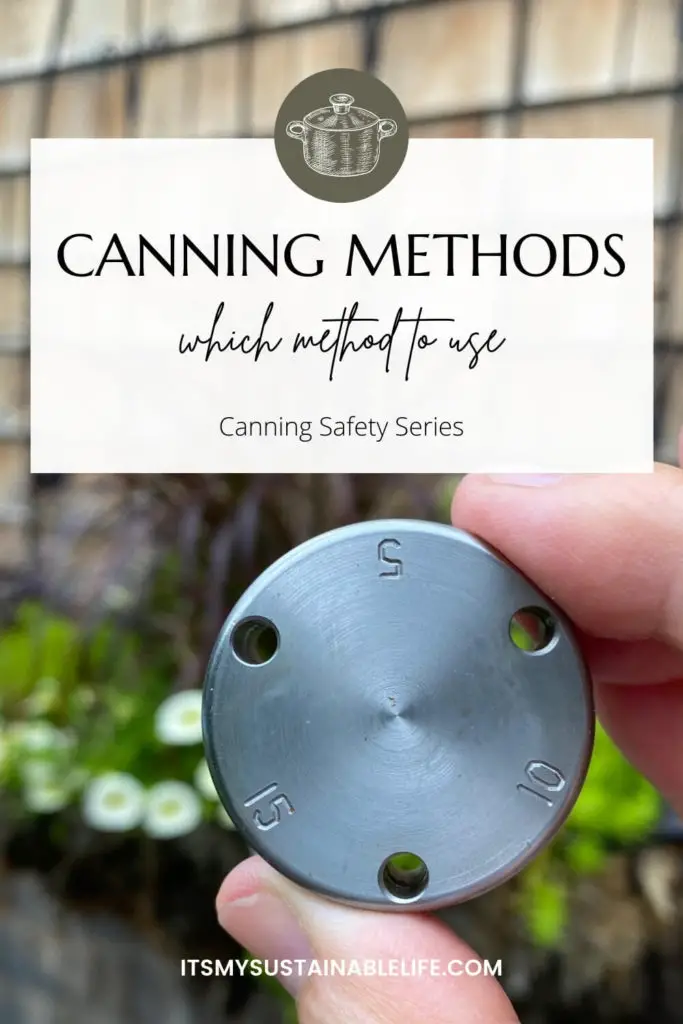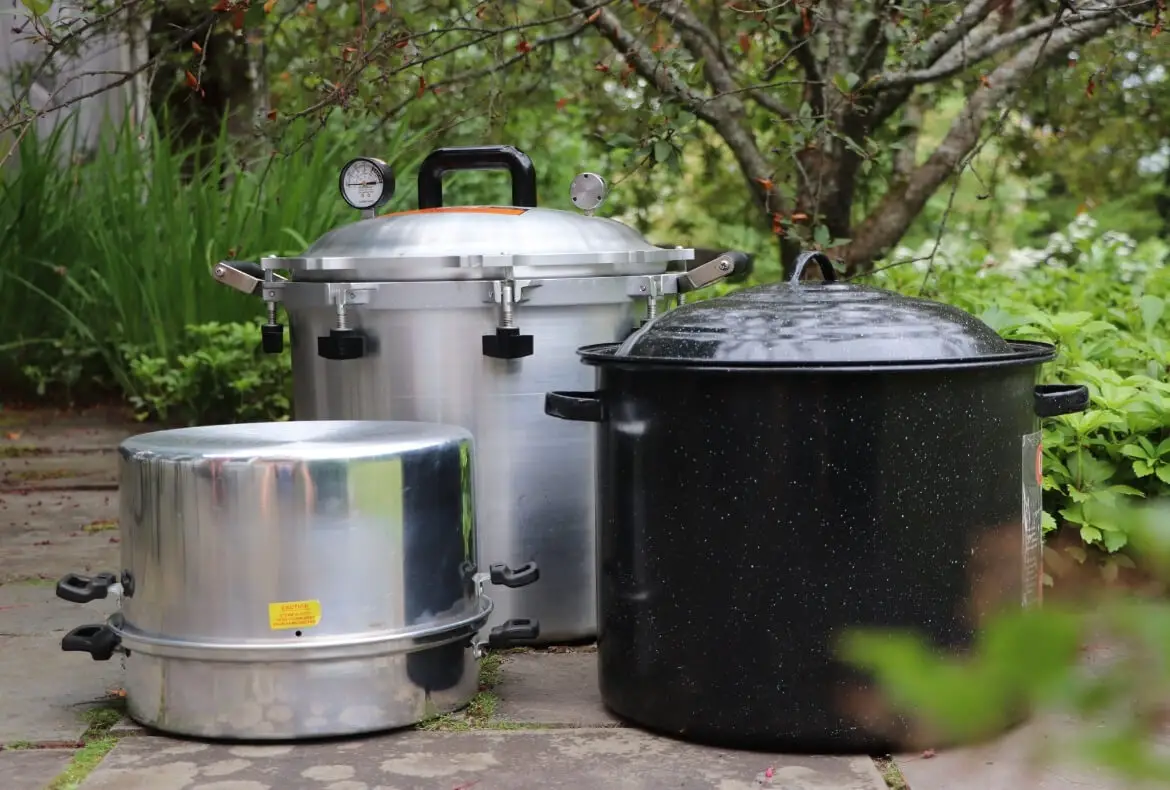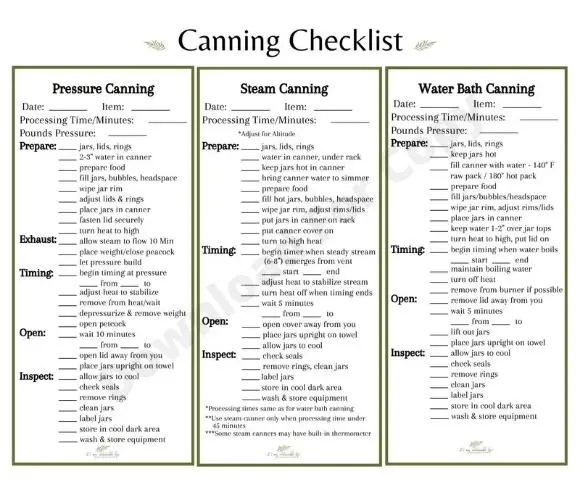Choosing the right canning method for the foods you are preserving is imperative to creating safe and healthy food for you and your family.
This post may contain affiliate links at no additional cost to you. By making your purchases through the links on this website, IMSL may make a small percentage at no direct cost to you. IMSL only promotes products we use & truly believe in. Please refer to my Privacy & Disclosures for further information. IMSL thanks you for your support!
In this 2nd article of the Safe Canning Series, we are exploring canning methods & deciphering which canning method is appropriate to use & when to use it.
Why can and preserve seasonal foods? Oh, for so many reasons! Seasonal eating is just healthier for us. Period. This study on the nutritional quality of organic, conventional, and seasonally grown food indicates that the longer it takes our food to reach us, the greater the loss of nutritive value of those foods become. Up to 50% lower!
Locally grown, fresh, seasonal foods just taste better! Ask anyone who loves tomatoes what their most looked forward to growing season is, and you can easily deduce what that season is 😊
Purchasing seasonally grown, local foods supports your local farmer & economy! I also believe it helps to encourage sustainable agricultural practices. Small producers tend to pay attention to what it is they are utilizing (pesticides, herbicides, and other harmful chemicals) to grow their food.
By keeping it local, a wide, wide world of diversity becomes available! When was the last time you saw a unique variety of tomato, such as Blue Beech Paste in your local grocers?
Locally grown & purchased foods helps the environment! Keeping it local helps to reduce the carbon footprint of our foods. Any assistance in that area is a good thing in my mind!
So why do I can these locally grown, seasonal foods? Well, I want access to all those nutrients, diversity, and taste come mid-winter! Not to mention, cost savings. As we eat organically here on the hill, we save a bit of $$$ by not having to purchase a large portion of our fruits and vegetables.
Although canning costs have increased greatly over the last year or so, by growing our own produce or purchasing in bulk from local growers, we are able to reduce our overall food expenses greatly. Some day I will need to sit down and figure out our total year’s food savings from our food preservation methods, canning being one of the favorites.
CANNING METHODS DEFINED
Canning methods are just that. The method or way you can or preserve your foods. It’s imperative that any canner follow safe canning practices that have been tried and tested. If you are just beginning on your canning journey, my favorite resource for safe canning practices, other than my own site 😊 can be found at the National Center For Home Food Preservation.
There are three methods, or ways, to can, also known as processing, foods. Water bath canning, pressure canning, and atmospheric steam canning.

Each canning method, when used properly for the appropriate foods (more on that below), will heat sealed jars to the right temperature needed to quell any unwanted spoilage or bacterium. As the jars are heated, or processed, air in the jars is forced out and as they cool an airtight vacuum seal is created.
It’s this vacuum seal that prevents air from re-entering the jars, thus keeping those spoilage organisms to the food itself at bay.
WATER BATH CANNING DEFINED
Water bath canning method is typically the method of choice for those just beginning. It’s user friendly, has inexpensive start-up costs, and fun to learn.
Water bath canning method is a simple process where jars are placed on a rack in a large pot or “canner”, like the one found below, covered by 1-2 inches of boiling water and processed for specific lengths of time (dependent on the product you are processing).
There are few guidelines which need to be met to safely use a water bath canner.
- It’s important to make sure the jars are completely surrounded by circulating hot, boiling water for even heat transference.
- A rack is necessary to ensure that water is completely circulating around the jar.
- The canner requires a lid for safe processing
- Although you can create your own “water bath canner” with equipment you already own, providing it meets all the above requirements, purchased canners make it easy and are very inexpensive.
PRESSURE CANNING DEFINED
The pressure canning method utilizes a sealed pot specifically made to build pressure when heated and maintain the required pressure needed in order to process your product safely. There are several types of pressure canners you can choose from.
DIAL GAUGE PRESSURE CANNER
This type of canner, the dial gauge pressure canner, has a dial that displays the pressure within the pot. These gauges may display a bit differently between models, but typically with show 1/2 or 1 pound increments or only 5# increments. That leaves a lot of “guessing” to determine the pounds in between. These models need to be monitored closely while processing, not so user friendly as other models in my humble opinion.
The dial gauge models do allow users to adjust for higher altitude levels (2000 feet or below pressure should be 11# when processing meats & vegetables & 6# for fruits).
Dial gauge models should be checked & tested at your local extension offices yearly for accuracy.
WEIGHTED GAUGE PRESSURE CANNER
The other option for pressure canners is a weighted gauge. Personally, my favorite.
The weighted gauge pressure canner has a weight that is placed on the unit while processing to control the pressure within the unit.

There are several types of weights to choose when purchasing your unit. One has a flat, round disk that displays 5, 10, and 15 pound markings with holes correlating to each pound marking for placement on the unit. The other has 3 metal rings that basically increase the weight to the appropriate pound you are looking to use. This is done by placing the rings on top of one another, each correlating to 5#’s. So all three rings would be placed on the weight should you need 15# pressure.
Once pressure inside the unit has been reached, the weight will begin to jiggle. Depending on which unit you choose will determine how often the weight should jiggle indicating that proper pressure is being maintained. Some jiggle as much as 3-4 times per minute and others will jiggle continuously.
I personally love this feature as I can use my hearing to be sure pressure is being maintained throughout the processing time.
When using weighted gauge pressure canners, vegetables & meats should be processed at 10# pressure, fruits 5# pressure (altitudes 1000 feet and above should add 5# pressure to that).
The beauty of weighted gauge pressure canners? They don’t require any testing other than a few visual safety checks before using.
ATMOSPHERIC STEAM CANNERS
There are scientifically approved studies showing it’s safe to use steam canning methods for certain foods (think peaches, pears, and apples, or acidified-foods such as salsa or pickles that are naturally high in acid) using specific steam canners. I personally am so happy to hear this as steam canning reduces water consumption when processing.
That being said, steam canning is now considered safe as research has shown the internal temperatures of steam canners reach the same as boiling water (water bath canning) of 212F.
Atmospheric steam canners have a base with a rack and a tall upper body or lid that fits over the jars once placed on the rack. This tall lid will have several holes which allow the steam to escape during processing, and should never be removed during the processing time. This steam needs to reach a length of 6-8 inches for proper processing.
It should be noted, that foods which require processing longer than 45 minutes should be processed using the water bath canning method as the steamer can, well, run out of steam 😂
WHICH CANNING METHODS ARE THE SAFEST
Many ask, “what is safe canning?”. What exactly does it mean to safely can your food? Personally, I feel it means knowing which canning method is appropriate & safe to use for which foods.
In addition, ALWAYS refer to safe canning recipes only like the ones listed here on my site or at the NCFHFP or even at those listed at your local extension offices.
To can safely really boils down to the foods you choose, thus determining which canning method you will utilize. Here are few guidelines I recommend of how to narrow your choices of the foods you will preserve.
- GARDEN – Look to your own garden first. What are you growing that you would enjoy in the coming winter months? What crop do you have an over abundance of at the moment? What does your family miss eating during the colder months or eat a lot of?
- FRESH – Use only unblemished, disease free, fresh produce to can. Preferably harvested the day of canning.
- SEASONAL – What’s in season at the moment that you could purchase in bulk from your local grower? Organic is best, but should you not be able to source what you need organically, refer to my Natural Fruit And Veggie Wash to help clean your produce up as much as possible.
Once you have determined what it is that you will be canning, you can then decide which canning method is to be used.
WHICH CANNING METHOD IS BEST FOR WHICH FOODS
Like most things, all food is not created equal. It’s these unique qualities of individual foods that we have to take into consideration when canning.
Determining which canning method is best for which foods really depends on the acidic level of the foods themselves.
As I certainly can never remember which foods are high acidic foods and which are lower, I always need to refer to my safe canning recipes for those foods to assist in determining which canning method I will be using.
Be sure to keep an eye out for a complete list of foods that you can preserve and which you cannot coming up soon! I may be writing this article for you as well as someone you may know 😉
Until then, remember these simple guidelines.
- LOW ACID FOODS – Foods that are considered low acid foods are those that, well, contain very little natural acid. The foods that have a pH level of more than 4.6. These are the foods that you will want to choose the pressure canning method to process.
- HIGH ACID FOODS – High acid foods are those that naturally boast a pH of 4.6 or less. As these foods have enough acid to inhibit any Clostridium botulinum (the bacteria that can cause botulism). They can safely be preserved using the lower temperature water bath canning method or atmospheric steam canning method. Water bath canning & steam canning can also be utilized for recipes with the correct amount of acid added.
SAFE FOODS TO CAN IN PRESSURE CANNER
Any food that is considered a low acid food can pretty much be pressured canned, with the few exceptions that will be mentioned below.
You will want to utilize the pressure canning method for foods such as vegetables (with the exception of acidified tomatoes, pickles, and sauerkraut), meats, soups, seafood, & dried beans.
SAFE FOODS TO CAN IN WATER BATH CANNER
Those foods that boast high pH levels will want to be preserved using the water bath canning method.
Think fruits, juices, acidified tomato products, jams & jellies, salsa’s, chutneys, sauces, pickled products, relishes, pie fillings, condiments, and vinegars.
SAFE FOODS TO CAN IN STEAM CANNER
High acid foods with a pH of 4.6 or below can be safely canned in a steam canner when proper guidelines are followed. The University of Wisconsin-Madison has a great steam canner guideline that you can follow.
As they have determined it is now safe to utilize a steam canner for any approved, tested recipe that can be water bath canned, simply look above to the high acid food list for water bath canning to find those foods that can now be safely canned in a steam canner.
UNSAFE FOODS TO CAN
There are a few foods that just should not be canned. Ever. Using any canning method. Period.
- DAIRY PRODUCTS – Dairy foods are low in acid and will easily support the growth of bacteria. Should you want to preserve foods with dairy products, choose to freeze them instead of processing.
- EGGS – There has been no conclusive testing for processing eggs of any kind, and that includes pickled. Keep it safe and refrigerate.
- OILS – A coating of oil can and will most likely create the perfect conditions for bacteria to grow. Pesto, sauces, herbs, or vegetables with oil added should be avoided when processing.
- STARCHES – Avoid using any form of starch or thickeners (flour, cornstarch, Clear Jel, tapioca) unless it is included in a tried and true, safe canning recipe. And there are very few that I can think of here. Starch can interfere with proper heat transfer during processing.
- PASTA & RICE – Avoid adding any form of pasta or rice to your recipes when canning due to their starch content.
- DENSE PUREES – Food purees such as pumpkin are dense. This density can prevent proper heat distribution throughout the jar when processing. Instead think of canning in a cubed or larger form and pureeing before use or freezing.
- FOODS THAT ARE TENDER – Certain foods are just tender, and would become mushy should you choose to process them. Think broccoli, cauliflower (although you can pickle and can this one), eggplant, and summer squash here.
- BAKED GOODS – Bread, cakes, muffins, etc are not safe to can or bake in canning jars. The jars themselves are not made to bake in, they most likely will shatter.
UNSAFE CANNING METHODS
Just as there are acceptable, safe canning methods, so too there are unsafe ones. The following list is just that. Unsafe ways to can or process your foods safely.
- SOLAR CANNING – Utilizing heat generated from solar or the sun is unsafe in all methods of canning
- OVEN CANNING – Oven canning is definitely a no, no in the safe canning practices world. Oven canning, or placing jars into a heated oven with uncovered jars is not safe; jars are not made to withstand dry heat and may shatter. Heat transfer is much slower through air, and no safe canning recipes could be found for oven canning.
- OPEN KETTLE CANNING – Open kettle canning method is where hot food is transferred to jars and sealed without further processing. Obviously the recommended amount of heat required in safe canning methods is not met utilizing this method.
- MICRO-DOME FOOD PRESERVER – This product has been recalled and the US Consumer Product Safety Commission recommends that any food processed using this preserver be destroyed.
- MICROWAVE PROCESSING – Heat used to process this way is not uniform and allows for increased risk of the jars exploding.
- DISHWASHER PROCESSING – Dishwasher temperatures are far below what’s required for safe canning methods resulting in under-processed foods that will be unsafe to consume.
- DRY CANNING – Due to no liquid being added for processing and distributing the necessary heat evenly throughout the product increasing risk of bacteria development.
UNSAFE CANNING PRACTICES
I would be remiss if I didn’t mention a few canning practices that are truly untested, and unsafe.
First and foremost, your Grandmother’s recipe for those green beans may no longer be safe. Why? Typically due to the fact that processing times from yesteryear are no longer viable and considered safe by today’s standards.

That being said, there are a couple more canning “practices” that are considered unsafe.
DO NOT use any chemical or preserving powders unless directed to do so by a tested, safe canning recipe. Aspirin should NEVER be used as a substitute for heat processing. Period.
The only additives that are considered safe to use are crystalline citric acid monohydrate, lemon juice from concentrate, tomato acidification tablets and ascorbic/citric acid mixtures.
DO NOT take shortcuts, or perform any home experiments. Again, only use tested, currently approved safe canning methods & recipes.
Always be sure to follow the directions and the recommended processing times exactly as stated in the recipe.
DO NOT use any canning supplies such as jars, lids, or cans unless they are made specifically for canning.
Saved pickle jars etc. should be kept for the everyday use in the kitchen only.
DO NOT re-use old rubber rings with zinc lids. Plan on replacing with metal two-piece lids which have the safe sealing compound.
CANNING CHECKLIST CHEATSHEET
To help you along with your processing efforts, I’ve created a unique FREE Canning Checklist cheatsheet listing all three methods of processing; pressure canning (article coming soon as well!), steam canning (instructional tutorial coming soon!), and water bath canning.
Print and laminate your copy of the Canning Checklist cheatsheet to use over and over again when processing! Simply use a washable marker to check off the list as you go! Once complete, wash the laminated list and you are ready for the next time you process!
Be sure to grab your FREE copy by clicking the button below 😊
Keeping yourself, your family, and those gifted with your canning efforts safe is of the utmost importance. By following the canning methods outlined as well as the safe canning practices mentioned, & utilizing the FREE Canning Checklist, you will be enjoying that jar of your favorite, in season harvest come winter.
Which canning method will you be utilizing?
Love, Light, & Laughter ~

YOU MAY BE INTERESTED IN
Water Bath Canning For Beginners





21 comments
I have been canning for over 30 years but never heard about steam canning method! Great article!
I am so excited about his post. I wanted to start canning this year
Super important to know what you are doing. Canning the first time with someone of experience is a great idea!
This is awesome canning information! Coming from a childhood where we grew most of what we ate, I wish we knew some of these things too! Maybe someday I’ll share some of our methods with you too!
I look forward to hearing about them! Thanks so much for reading 😊
I hope someday, after I’ve traveled a bit perhaps, to try canning! Your post are so helpful.
I enjoy reading your expert advice on canning. It is something I probably will never attempt but you make it sound simple enough.
Great, complete info on canning. When my girls were growing up, we canned a bit, especially jams and jellies from wild fruit, but haven’t in years.
I’m impressed at how much you do!
Thanks for the helpful information. I have been hesitant to start canning for fear of doing it wrong.
I’d never done canning before and I had a friend offer to do canning at my house… with the oven. It was so HOT and miserable and I still questioned if it was safe. When I can next time, I’ll be sure to follow your steps!
Yes, when canning you definitely want to follow only researched & proven safe canning methods. Hope you will give it another try!
This is a great guide for someone like me, who is just starting out! So far, I have only done pie fillings and pasta sauce. I would like to expand the repetoire, so I will be Pinning for later!
So glad you’ve found this useful, Marianne! Happy canning 😊
I’ve always wanted to try canning. Great info!
I have never heard of the Atmospheric Steam Canning method. I knew there a few unsafe ways of canning food, but good to know there is another great option that has quite a bit of research behind it.
When our children were growing up I canned everything. Now, our adult sons have my equipment and do the same.
Love that you have passed this skill along! Thank you for reading, Christina!
Love your canning tips and advice! We love to make our own jams and especially pickles…although one of my dogs has eaten most of my cucumber plants I see so I am hoping they return! I may also give it a try with beans this year.
I learn so much from your posts! I have never considered canning before. A lot to think about!
This is great information. I never knew there were so many types of canning.
I had no idea there was that many ways to can food. I’ve only done the water bath one and it took me years to get up the courage to do it 😂